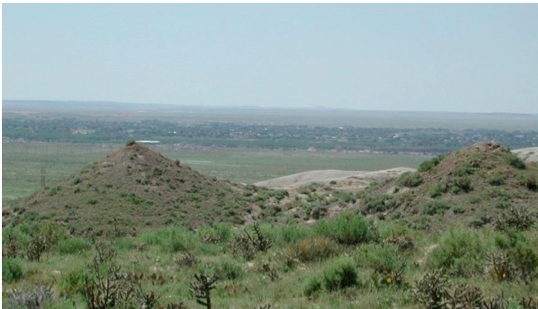Tepee Buttes on our Horizons
By Cindy Smith
Fremont County Stones 'n Bones
Used with Permission
We've all seen them. The mesmerizing little pyramids on the plains left behind some 75 mya when the huge but shallow Western Interior Sea retreated. This sea once stretched from the Gulf of Mexico to Hudson Bay. It was only 200-400' deep, and it ran right through Fremont County.
These head-turners, called Tepee Buttes, are not random nor barren. They offer an insight into ages past when marine life found the hydrocarbons at their core life-giving.
Fremont County has its own Tepee Buttes on private land, though there are more well-known Tepee Buttes east of Pueblo near Baculite Mesa and near Boone (where over 50 buttes cover 1.5 square miles). Mt Pleasant, better known as Spud Hill, in eastern Canon City was a Tepee Butte before being bulldozed, and was a local source of many back garden ornaments.
Read More...
Fremont County Stones 'n Bones
Used with Permission
We've all seen them. The mesmerizing little pyramids on the plains left behind some 75 mya when the huge but shallow Western Interior Sea retreated. This sea once stretched from the Gulf of Mexico to Hudson Bay. It was only 200-400' deep, and it ran right through Fremont County.
These head-turners, called Tepee Buttes, are not random nor barren. They offer an insight into ages past when marine life found the hydrocarbons at their core life-giving.
Fremont County has its own Tepee Buttes on private land, though there are more well-known Tepee Buttes east of Pueblo near Baculite Mesa and near Boone (where over 50 buttes cover 1.5 square miles). Mt Pleasant, better known as Spud Hill, in eastern Canon City was a Tepee Butte before being bulldozed, and was a local source of many back garden ornaments.
Read More...
Legend of the Indian Maiden on Fremont Peak
Excerpt from The Cañon City Daily Record, Yesteryear by U. Michael Welch, Used with permission.
Looking at the surrounding mountains, there is a mystique about various shapes, especially the ones steeped in legends. The most notable is Fremont Peak to the west of Cañon City. Where locals are aware of and visitors can see an outline of a sleeping Indian on the horizon.
As to legend, Cañon City was once the spot for Native Americans to spend the winters, where they bathed in the hot springs, searched for comfortable shelter and hunted.
One year the Utes were camped near the river when a band of Blackfoot Indians came into the area.
While living in the -area, the Blackfoot braves could not find enough to eat, and they noticed there was food hanging in the Ute encampment.
Read More...
Looking at the surrounding mountains, there is a mystique about various shapes, especially the ones steeped in legends. The most notable is Fremont Peak to the west of Cañon City. Where locals are aware of and visitors can see an outline of a sleeping Indian on the horizon.
As to legend, Cañon City was once the spot for Native Americans to spend the winters, where they bathed in the hot springs, searched for comfortable shelter and hunted.
One year the Utes were camped near the river when a band of Blackfoot Indians came into the area.
While living in the -area, the Blackfoot braves could not find enough to eat, and they noticed there was food hanging in the Ute encampment.
Read More...
Phenakite: an Elusive Pegmatite Mineral
by Bob Carnein
Reprinted here by permission from Bob Carnein. Also published in the LGGMC September 2015 Newsletter.
|
Phenakite (aka phenacite; pronounced feen’-uh-kite) is a rare beryllium silicate mineral (formula Be2SiO4) that occurs as excellent crystals at several Colorado localities. For the beginning collector, it’s one of the most difficult minerals to identify, commonly being confused with the much more common quartz and topaz. This article is designed to help you to recognize this elusive and often overlooked mineral.
Properties. The name phenakite comes from the Greek phenakos, meaning “a deceiver”, because of its resemblance to quartz (Klein and Hurlbut, 1999). Phenakite occurs in the rhombohedral division of the hexagonal crystal system. If you look carefully, crystals are usually clearly hexagonal (Figs. 1, 2), which helps one to distinguish phenakite from topaz, whose orthorhombic crystals are often rectangular or diamond shaped in cross section. Be aware, though, that some topaz crystals look superficially hexagonal. Both Read More... |
PALEONTOLOGICAL RESOURCES PRESERVATION: HOW THE FOREST SERVICE DISCOURAGES ROCK AND MINERAL CLUBS FROM COLLECTING INVERTEBRATE FOSSILS AND PLANTS
Reprinted here by permission from Mike Nelson. Also published in the CSMS July Pick and Pack.
Written by Mike Nelson [email protected]
DISCLAIMER: THE FOLLOWING IS MY OPINION AFTER READING, AND TRYING TO UNDERSTAND, PART 291 PALEONTOLOGICAL RESOURCES PRESERVATION RULES EFFECTIVE MAY 18, 2015, AS PUBLISHED IN THE FEDERAL REGISTER.
Recently the Federal Register published new rules for collecting common invertebrate and plant fossils on land managed by the US Forest Service (USFS), and presumably soon to be copied by the BLM. In my opinion these new regulations are among the most inelegant that I have observed in the federal bureaucracy. I just want readers to understand that the new fossil collecting regulations will/could affect fossil collecting field trips by individuals, rock and mineral clubs and
Read More...
Written by Mike Nelson [email protected]
DISCLAIMER: THE FOLLOWING IS MY OPINION AFTER READING, AND TRYING TO UNDERSTAND, PART 291 PALEONTOLOGICAL RESOURCES PRESERVATION RULES EFFECTIVE MAY 18, 2015, AS PUBLISHED IN THE FEDERAL REGISTER.
Recently the Federal Register published new rules for collecting common invertebrate and plant fossils on land managed by the US Forest Service (USFS), and presumably soon to be copied by the BLM. In my opinion these new regulations are among the most inelegant that I have observed in the federal bureaucracy. I just want readers to understand that the new fossil collecting regulations will/could affect fossil collecting field trips by individuals, rock and mineral clubs and
Read More...


